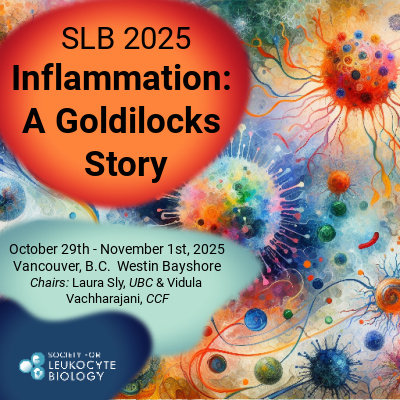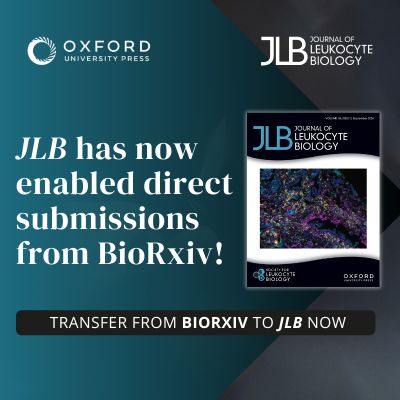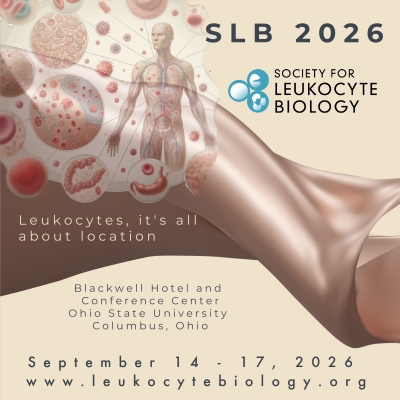| JLB Vol 111 Issue 3 TOC |
ISSUE INFORMATION Issue InformationPages: 509-514 | First Published:25 February 2022 EDITORIAL SPOTLIGHT ON LEADING EDGE RESEARCH Specific innate immune cells uptake fetal antigen and display homeostatic phenotypes in the maternal circulation Marcia Arenas-Hernandez, Roberto Romero, Meyer Gershater, Li Tao, Yi Xu, Valeria Garcia-Flores, Errile Pusod, Derek Miller, Jose Galaz, Kenichiro Motomura, George Schwenkel, Robert Para, Nardhy Gomez-Lopez
Pages: 519-538 | First Published:10 December 2021 CELL DEVELOPMENT, DIFFERENTIATION, AND TRAFFICKING Acetyl‐CoA carboxylase‐1/2 blockade locks dendritic cells in the semimature state associated with FA deprivation by favoring FAO Thuy Nguyen-Phuong, Hyunwoo Chung, Jiyun Jang, Jung-Sik Kim, Chung-Gyu Park
Pages: 539-551 | First Published:24 May 2021 LncRNA TUG1 ameliorates diabetic nephropathy via inhibition of PU.1/RTN1 signaling pathway Dongdong Meng, Lina Wu, Zhifu Li, Xiaojun Ma, Shuiying Zhao, Di Zhao, Guijun Qin
Pages: 553-562 | First Published:01 June 2021 RECEPTORS, SIGNAL TRANSDUCTION AND GENES The Akt–mTORC1 pathway mediates Axl receptor tyrosine kinase‐induced mesangial cell proliferation Yuxuan Zhen, Tracy L. McGaha, Fred D. Finkelman, Wen-Hai Shao
Pages: 563-571 | First Published:04 July 2021 INFLAMMATION, EXTRACELLULAR MEDIATORS, AND EFFECTOR MOLECULES Human monocytes store and secrete preformed CCL5, independent of de novo protein synthesis Arvin Tejnarine Persaud, Stephen Andrew Bennett, Laxshaginee Thaya, Jonathan Burnie, Christina Guzzo
Pages: 573-583 | First Published:11 June 2021 Melanoma‐derived extracellular vesicles skew neutrophils into a pro‐tumor phenotype Daniel Guimarães-Bastos, Ana Clara Frony, Christina Barja-Fidalgo, João Alfredo Moraes
Pages: 585-596 | First Published:27 May 2021 Activation of human γδ T cells and NK cells by Staphylococcal enterotoxins requires both monocytes and conventional T cells Manuel Mata Forsberg, Claudia Arasa, Willemien van Zwol, Sibel Uzunçayir, Anna Schönbichler, Paulina Regenthal, Jenny Schelin, Karin Lindkvist-Petersson, Sophia Björkander, Eva Sverremark-Ekström
Pages: 597-609 | First Published:11 June 2021 FOXO3a acetylation regulates PINK1, mitophagy, inflammasome activation in murine palmitate‐conditioned and diabetic macrophages Priya Gupta, Gaurav Sharma, Amit Lahiri, Manoj Kumar Barthwal
Pages: 611-627 | First Published:20 July 2021 Macrophage inflammatory state influences susceptibility to lysosomal damage Amanda O. Wong, Matangi Marthi, Amanda Haag, Irene A. Owusu, Christiane E. Wobus, Joel A. Swanson
Pages: 629-639 | First Published:14 July 2021 LncRNA NEAT1_1 suppresses tumor‐like biologic behaviors of fibroblast‐like synoviocytes by targeting the miR‐221‐3p/uPAR axis in rheumatoid arthritis Manli Wang, Yixiong Chen, Xuan Bi, Xiqing Luo, Zuoyu Hu, Yan Liu, Xiaoyi Shi, Weizhen Weng, Biyao Mo, Yan Lu, Yunfeng Pan
Pages: 641-653 | First Published:12 July 2021 HOST DEFENSE AND PATHOPHYSIOLOGY Elevated F‐EDN correlates with mucosal eosinophil degranulation in patients with IBS—A possible association with microbiota? Maite Casado-Bedmar, Felipe Meira de-Faria, Olga Biskou, Carl Mårten Lindqvist, Purnika Damindi Ranasinghe, Olga Bednarska, Christer Peterson, Susanna A. Walter, Marie Carlson, Åsa V. Keita
Pages: 655-665 | First Published:21 June 2021 SYSTEM BIOLOGY AND IMMUNOGENETICS Use of integrated metabolomics, transcriptomics, and signal protein profile to characterize the effector function and associated metabotype of polarized macrophage phenotypes Catherine B. Anders PhD, Tyler M.W. Lawton, Hannah L. Smith, Jamie Garret, Margaret M. Doucette DO, Mary Cloud B. Ammons PhD
Pages: 667-693 | First Published:09 August 2021 REVIEWS Role of IL‐6 in dendritic cell functions Yu-Dong Xu, Mi Cheng, Pan-Pan Shang, Yong-Qing Yang
Pages: 695-709 | First Published:18 August 2021 The interaction between iNKT cells and B cells Tong Zhu, Rongli Wang, Heather Miller, Lisa S. Westerberg, Lu Yang, Fei Guan, Pamela Lee, Quan Gong, Yan Chen, Chaohong Liu
Pages: 711-723 | First Published:27 July 2021 Review - COVID-19 and Related Topics Scientific premise for the involvement of neutrophil extracellular traps (NETs) in vaccine‐induced thrombotic thrombocytopenia (VITT) Junaid Kashir, Ayesha Rahman Ambia, Areez Shafqat, Muhammad Raihan Sajid, Khaled AlKattan, Ahmed Yaqinuddin
Pages: 725-734 | First Published:01 September 2021 |





















